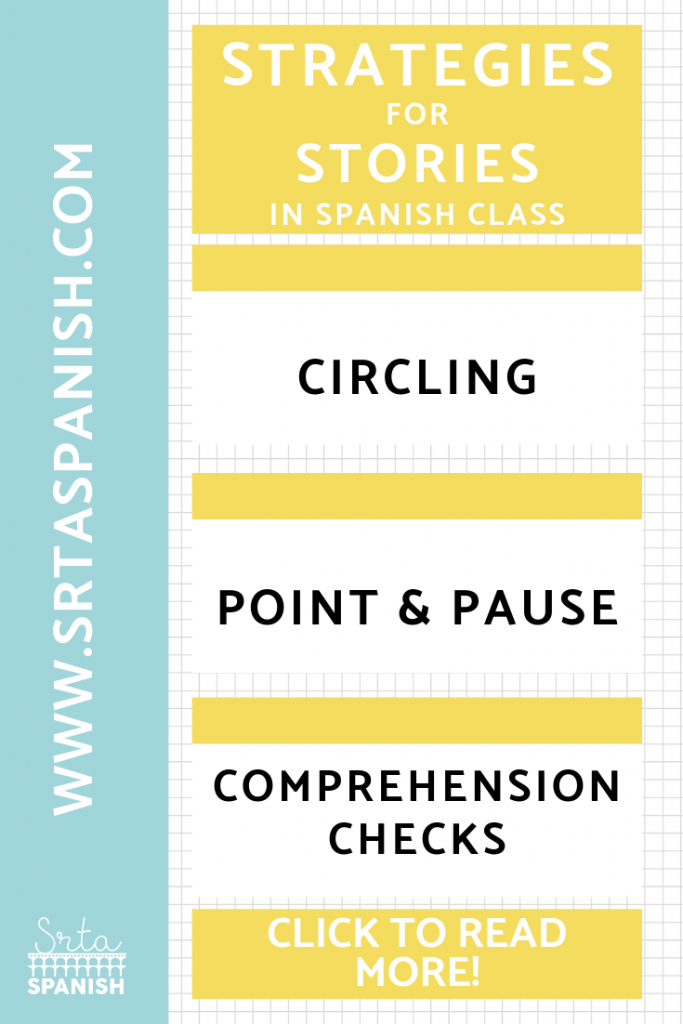Over the past few weeks, I have been sharing tips and tricks on how I use stories in my Spanish classroom. From expectations for student participation, student jobs during a class story, to different methods to share a story in your Spanish class, I’m trying to cover everything you need to know about stories in your classroom! Part Four of this series is here! It’s time to discuss strategies for telling stories in Spanish class.
Whether you use story telling or story asking, there are several key strategies you need to incorporate. Circling, point and pause, and comprehension checks are huge so we’re going to go over each of them!

Circling During a Story
The concept of circling is simple. The process goes something like this:
1. Make a statement.
2. Ask a question about the
3. Ask a question about the
4. Ask an either/or question.
5. Ask an
Example:
1. There is a dog.
2. Class, is there a dog? (They answer). Yes
3. Class, is there a boy? (They answer). No class, there is a dog.
4. Class, is there a dog or a boy? (They answer).Right class, there is not a boy, there is a dog.
5. Class, what is there? (They answer). Yes
You don’t have to do every single one of those steps with every single sentence in your story. As your students progress, you won’t need to circle 1-5 for statements like, “There is a dog”. Keep in mind that Step 5 can also be really tricky! Open ended questions require them to produce the language on their own, rather than a simple y/n or either/or kind of question. Save them for after they’ve gotten several repetitions of the answer, or when you want to challenge the students.
Also notice how in the example after each answer you should restate the original sentence. Affirm the statement! This step is really important to verify the information and their accuracy!
If you’re not familiar with circling, I highly recommend finding some YouTube videos to watch! It’s hard to get the concept from reading, but I think watching other people do an example really helps. There are tons and tons of great YouTube channels out there where you can see this!
Click here for more info on circling!
Point and Pause
Point and pause is a technique using visual supports. Use posters you have hung in class, write on your whiteboard, and have key structures projected during a story. Point to the structures or the words as you say them, pausing to give students time to process.
In particular I try to be really intentional with this for things like “le dio” and “le dijo” because students confuse the two in their writing so I’m trying to make sure they see the words and make the connections.
I also have to occasionally check and make sure my body isn’t physically blocking one side of the room as I’m pointing. It’s no help if they can’t see what you’re pointing to! Above all, make sure you are clear and slow as you state and point.
Comprehension Checks
Comprehension checks are so so SO important. It’s called comprehensible input for a reason! Circling involves lots of comprehension checks, as you ask them a billion questions, but you can also just pause and ask, “Who can tell me what I just said?” and then keep going. English isn’t a terrible, awful enemy. We just don’t want it to be the main vehicle in our classrooms.
Sometimes I do this when the circling is going super fast – they’re really really responding OR they’re not responding. Sometimes I can’t tell if they’re not responding because they’re like, “YEA. Profe, we got it!” or if they’re confused. A quick check and

Have you tried any of these strategies for Stories in your Spanish Class? What questions do you have for me? Drop a comment below and let me know!


Leave a Reply